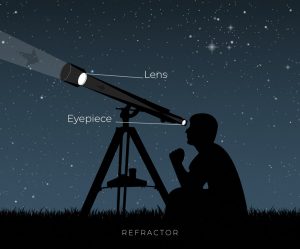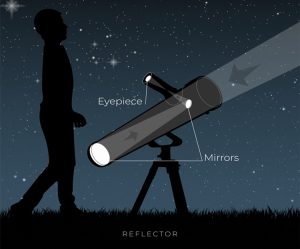
Refractor telescopes
A refractor's size is specified by the diameter of the lens at the front of the telescope (which is called the aperture), and the f/stop. Multiplying the f/stop by the aperture gives the focal length expressed in the units used for the aperture. So a 4 inch f/9 refractor would have a focal length of 36 inches.
The magnification of a refractor depends on its focal length, the focal length of the eyepiece, and the magnification of any barlow lens inserted between the eyepiece and the telescope. To find the system magnification, divide the focal length of the refractor by the focal length of the eyepiece. (see eyepiece, below.) If a barlow is used, then multiply by the magnification number marked on the barlow. For example, a 60mm f/8 refractor with a 12mm eyepiece would have a system magnification of 40x. With a 2.5x barlow added, the magnification would be 100×.

Reflector telescopes
A reflector telescope's size is given by two figures: the aperture, which is the diameter of the primary mirror, and the focal length. Dividing the focal length by the aperture, when both are expressed in the same units, gives the f/stop. So a reflector with a 48 inch focal length and a 6 inch aperture would be f/8. A larger aperture is not an unmixed blessing, because the effects of air turbulence are more pronounced. The quality of a reflector depends on the quality of the mirror. In 1879, Lord Rayleigh observed that an optical instrument was as good as perfect if the difference between the longest and shortest optical paths to the focus did not differ by more than 1/4 wavelength.
Optics meeting this criterion have come to be called “diffraction-limited.” There are different ways of expressing this tolerance. One way is to require that the highest zone on the mirror cannot be more than 1/8 of a wave higher than the lowest zone. The R.M.S. value for a mirror is typically 4 to 6 times smaller than the peak-to-valley error. Trials have shown that beginning observers can easily detect improvements in image quality up to ? wave; improvement beyond that is more apparent to observers with extensive training and experience.

Telescope eyepieces
Eyepieces for consumer refractors are interchangeable with those for reflectors. They are sized by focal length (of the eyepiece, not the telescope) and outer diameter.
Standard outer diameters are 0.965 inch (mostly found on economy imports), 1.25 inches (the most common) and 2 inches (mostly found on premium low-power or wide-angle eyepieces). Adapters are sold which make it possible to put 1.25 inch eyepieces in focusing mounts made for 2-inch eyepieces. To use 1.25 inch eyepieces in an 0.965-inch mount, a “hybrid star diagonal” can be used, which inserts a mirror between the focusing mount and the eyepiece.
Available focal lengths range from 2.5 mm to 80 mm, with 5 to 40 being a more normal range. An eyepiece's focal length is marked on it. In a marking like AH20, the letters indicate the optical construction and the numbers are the focal length in millimeters.
Users ordinarily have a set of eyepieces; they change the telescope's magnification by changing eyepieces. The shorter the focal length of the eyepiece, the greater the magnification. However, past a certain point increasing the magnification by using a shorter focal length eyepiece produces only “empty magnification”: the image is bigger, but also fuzzier, so that no additional detail can be seen.
As a rule of thumb, the greatest useful magnification will be 50× to 60× per inch of aperture. So a four-inch telescope would have a maximum usable magnification of about 200× to 240×. If the telescope had a focal length of 1200 mm, the shortest sensible focal length eyepiece would be (1200 ÷ 200 =) 6 mm.
Eyepieces with the same focal length but different optical designs may have different apparent fields of view. The apparent field of view is expressed as an angle in degrees. To find the actual field of view with any particular eyepiece, divide the apparent field by the telescope's magnification.
A characteristic of eyepieces which is important to eyeglass wearers is eye relief, the maximum distance an eye can be from the top lens of the eyepiece and still see the entire field. When manufacturers provide this information, it is usually given in millimeters.